-

人教版新目标初中英语八年级上册How do you make a banana milk shake教案2篇
1. First, ... then, ... next, ... finally, ...首先,……然后,……接着,……最后,……这是英语中表达做某事的步骤的一种说法。如果步骤较多,还可以说:first-next-after that-later on-finally/at last通常你会听到说英语国家的人在说 first, next, then, finally 和后面的内容时,他们会做一些停顿。这样就能提前告诉听者接下来讲的是一系列的步骤。这一点在朗读和听力中应特别注意。2. how many, how much均为疑问词,同是“多少”,但用法不同。请看:how many修饰可数名词复数,how much修饰不可数名词。但在用法上,同学们常犯如下错误:1) [误] How many are there bananas on the table?[正] How many bananas are there on the table?[析] how many, how much 中的many,much是形容词,常修饰名词作定语,故后面跟名词。2) [误]How much tea are there on the table?[正]How much tea is there on the table?[析] how much修饰不可数名词时,谓语动词用单数。how many与how much的区别可简记为:前how many:问“多少”,复数名词后面跑;how much问“多少”,不可数名词单数好。前者答语用基数词,后者答语用数量关系。

人教版新目标初中英语八年级上册How was your school trip教案2篇
“Go for it!” is based on “Task-Based Language Teaching”. It adheres to “The authenticity principle”, “The form-function principle”, “The task dependency principle” and “The principle of learning by doing”. These principles all accord with the demands of curriculum focus.In and of Grade Seven (II), “Go for it!”, students have learned “The Simple Past Tense”. And it appears again in of Grade Eight (I). teaches students more about how to talk about events in the past. In addition, it gives affirmative and negative statements in the past tense, such as the sentence patterns “Did you see …?” “Were there …?” “Did you go …?” As the first part of Unit 8, Section A opens with a picture presenting the last school trip in the aquarium and continues with several step-by-step practice activities, which are all good for students to master “The Simple Past Tense”. Doing well in Section A will help students integrate the new target language with that in Section B. Thus, they can describe the events in the past freely and foster their own ability of reflecting and practicing. II. Teaching ObjectivesTeaching objective is the beginning and aim of teaching activities. According to the overall goal of the English elementary course--- improve students' synthetic ability of language application, which should be based on the development of students’ “Language knowledge”, “Language skills”, “Character building”, “Learning strategies” and “Cross-cultural awareness”. The teaching objectives are described as follows(I). Knowledge objectivesi. Master the simple past tense of regular and irregular verbsii. Recite the new words and expressions about the last school trip in the aquarium, including their pronunciation and intonation

人教版新目标初中英语八年级下册If you go to the party, you’ll have a great time教案2篇
区分宾语从句、定于从句和状语从句宾语从句和状语从句,都叫做主从复合句。宾语从句主要是中考必考的,是初中阶段必掌握的从句,宾语从句主要是掌握三要素,所谓宾语从句,就是宾语在主从复合句当中充当宾语的一个句子,叫做宾语从句。主句的谓语动词是及物动词,后面如果是词或者是短语的话,是简单句,如果是句子的话,肯定是宾语从句。I know that he good at English.就是宾语从句,三要素,一要素是要注意连词,连词一共学了三类连词,一类连词是that口语当中可以省略,就像刚才说的那一句,I hear he is good at English.还有疑问代词、疑问副词,how where when,疑问代词、疑问副词。还有一类连词weather是否的意思,不是状语从句当中的如果,这一定要和如果区分开,这是是否。I don't know if he interested at English。宾语从句要注意if是连词。第二要素是语序,要用陈述举语序。比如说你家有几口人,我们都说How many people are there in you family?但是这是简单句,一旦说成宾语从句,你可以告诉我你家有几口人吗?Could you tell me how many people there are in you family ?

人教版新目标初中英语八年级下册It’s a nice day, isn’t it教案2篇
"Hello! Welcome to English class! Introduce yourself. Meet your new classmates." That's what the teacher says. What do you say? "Oh no!" It can be difficult talking to new people. But it can be fun, and you can make friends. How do you do it? Make small talk. Small talk is polite conversation. "Wang Nan is a great pingpang player, isn't she?" "I'd love to meet her, wouldn't you?" "It's been raining a lot, hasn't it?" Tag questions are a form of polite speech. To make small talk successfully, you should know how to make them. You should also know what topics to talk about. Try to learn this unit carefully. The next time you're in English class, you'll find out. Making small talk's easy, isn't it? (“你好!欢迎你!请做一下自我介绍。认识一下你的新同学。”通常在课上老师会这样说。你会说什么呢?“噢,不!”与陌生人谈话太困难了。但是这也很有意思,并且你还能交到朋友。你该怎么做呢?闲聊。闲聊指得是礼貌的对话。“王楠是一个很棒的乒乓球运动员,不是吗?”“我希望自己能认识她,你呢?“今年的雨水很多,不是吗?”反意疑问句是一种礼貌用语。为了使得谈话成功,你应该知道怎样去进行闲聊。你还应该知道与不同的人该谈论什么样的话题。认真的学习这个单元吧,下次在英语课上,你会发现与大家展开谈话是一件很容易的事情,不信我们来试试。)

人教版新目标初中英语八年级下册How long have you been collecting shells教案2篇
Step Ⅱ Show the new words on the screen and teach the new words. Read the new words to students and ask them to repeat.Step Ⅲ 3aThis activity introduces new vocabulary and provides reading practice using the target language.In this activity first look at the four pictures.T: What can you see in the pictures?Ss: Four snow globes.T: Right. There are four snow globes in the pictures. And what are they?Ss: They are a monster, two polar bears, two penguins and a birthday cake.Write these words on the blackboard: snow globe; monster; polar bear; penguin and birthday cake. Read them to the class and ask students to repeat each one. Make sure students understand each word.Use a computer to show the E-mail message on the screen and read the message to students.Get students to read the e-mail on their own, and then draw lines connecting each snow globe and its description.Correct the answers.AnswersA line should connect each snow globe picture with the words that describe it in the letter.Step Ⅳ 3bThis activity provides writing practice using the target language.First review Activity 2a on Page 47.Then ask students to complete the message according to Activity 2a.Some partial sentences are given to students. Write about one person's collection.When students work, walk around the room checking the progress and offering help as needed.When they finish, ask some students to read their messages to the class.

人教版新目标初中英语八年级下册What were you doing when the UFO arrived教案2篇
(一).知识方面: 1.培养学生能运用过去进行时来描述、谈论过去某个时间正在发生的事情或动作的意识和能力,能就过去某个时间正在发生的动作做出正确的描述。 2.培养学生的想象力和角色扮演的合作能力。 3.培养学生讲述过去发生的事情经过的能力。能正确运用一般过去时来讲述故事。 (二).技能方面: 1.本单元的语言目标是Talk about past events and tell a story(谈论过去的时间和讲述一个故事),围绕这一目标,要涉及句型: What were you doing when the UFO arrived? ----I was sitting in the barber’s chair. The barber was cutting my hair. 因此必须学习standing、studying、cleaning、sleeping、cooking、making、eating、cutting、等表示地点的词,以便为上述句型提供语言材料。2.学习过去进行时的有关知识。Was/were+现在分词,是该时态的表达式。 3.在学习过程中,要区分The boy was walking down the street when the UFO landed.和While the boy was walking down the street, the UFO landed.这两种由when和while引导的状语从句的句型结构。注意它们的不同。

人教版新目标初中英语九年级上册Teenagers should be allowed to choose their own clothes教案2篇
Step 1 Greeting Greet the class and check the homeworkStep 2 A duty report The S on duty gives a report on the rules in his home and lead in 3a “Sun Fei’s and Wu Yu’s rules” Step 3 ReadingSs read the conversation and write the two girls’ rules in the chart. Check the answers.Get Ss to read after the tape and then read aloud by themselves. Then, T explains the language points.Step 4 Pairwork 3bRole play. Use the information in chart to practice with the conversation in 3a covered. They can look at the sample conversation in the right box.Step 5 Task 2 “Who’s the best reporter?”Make a survey by asking any 5 students the questions in the chart in activity 4. Then give out a report about it. See who is the best reporter? And the best reporter will get a nice ball-pen.Step 6 Summary and homework:Write out the report in your exercise-books.Period ThreeStep 1 Greeting and a duty reportThe S gives a duty report talking about his experience of being late for school. Lead in the question “Do you ever get to school late? How often do you get to school late? Always, usually, sometimes, or never?Step 2 1a Get Ss to finish writing.Step 3 Pairwork 1b Get Ss to talk about their answers with their partners using the sample conversation in the box on the right.Step 4 Listening practice2a Lead-in: What will happen if you get to school late? What about Peter? Let’s listen to a conversation between Peter and his father. Get Ss to finish 2a (As usual, for the first time, Ss only listen.) Check the answers.

人教版新目标初中英语九年级上册How do you study for a test教案2篇
内容提示本单元主要内容是学会利用verb十by/with gerund表示方式方法来讨论学习英语的策略,认识自己在学习方面的长处和不足。初步了解现在完成时的结构和用法。现在完成时由助动词have/has+动词的过去分词构成,主要表示过去发生的某一动作对现在仍有影响或造成的后果,常与already,yet,just,ever,never等副词连用。教学目标一、学习目标(Language Goal) 1. Talk about how to study . 学会讨论各种学习方法和策略。2. Find out your suitable learning methods. 找出适合自己的学习方法。 二、语言结构(Language Structures) 1. Verb + by with gerund by+动名词短语 表示“通过…途径,方法” 2. How questions have引导的特殊疑问句 三、目标语言(Target Language) 1. How do you study for tests ? 你是怎样准备考试的?Well , I study by working with my classmates. 哦,我和同学们一起学习。2. Have you ever studied with a group ? 你曾经参加过学习小组吗?Yes , I have . I’ve learned a lot that way . 是的,参加过。通过这种方式我学了许多。

人教版新目标初中英语九年级上册Where would you like to visit教案2篇
The First PeriodⅠ.Teaching Aims and DemandsKnowledge Objects(1) Key Vocabularytiring, educational, fascinating, thrilling, peaceful, exotic, trek, jungle, take it easy, explore, historic, site(2) Target LanguageWhere would you like to go on vacation?I’d like to trek through the jungle, because I like exciting vacations.2. Ability Objects(1)Train students to talk about places they would like to visit with the target language.(2)Train students to describe vacations with different adjectives.(3)Train students' listening skill.3. Moral Object,It′s more interesting to go on vacating somewhere instead of staying at home.Ⅱ. Teaching Key Points1. Key Vocabularytiring, educational, fascinating, thrilling, peaceful, exotic, trek, jungle, take it easy, explore, historic, site2. Target LanguageTalk about different places with the target language.Ⅲ. Teaching Difficult Points1. Describe vacations with different adjectives.2. Talk about different places with the target language.Ⅳ. Teaching Methods1. Teaching by illumination2. Teaching by doing chain drills3. Teaching by pairworkⅤ. Teaching Aids1. A tape recorder2. Some pictures of different places with famous views
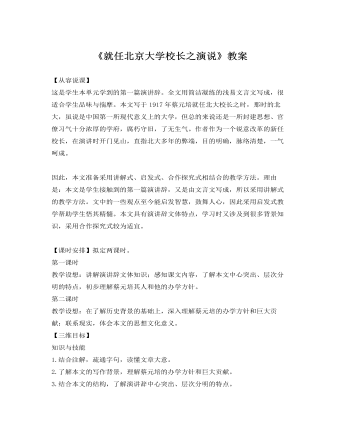
人教版高中语文《就任北京大学校长之演说》教案
蔡元培的道德风范和人格力量,具有震撼人心的作用,深为世人所钦仰。“人世楷模”“善良的社会和庄严的人生的模范”(国立音乐专科学校师生1936年1月《祝蔡孑民先生千秋诗》)的赞誉,对他来说绝非溢美之词。任鸿隽称他具有“处处为人无我的真精神”;“对人接物,似乎有两个原则,一个是尊重他人的人格,决不愿意以自己的语言和行动使人感到一点不快或不便,一个是承认他人的理性,以为天下事无不可以和平自由的方法互相了解或处理。”“但在公义一方面,蔡先生却是特立不屈、勇往直前、丝毫不退、毫不假借的斗士。”(重庆《中央日报》1940年3月24日)他的学生冯友兰也回忆说,在蔡先生身边,感同光风霁月,他的人格能造成一种气象。沐浴在这种气象之中,就不能不为他的人格所感化。蔡元培身居高位,一生廉洁,自奉俭朴,直至晚年仍是全家租赁房屋居住,他酷爱的书籍也分散在北平、上海、南京、杭州等地,没有一个归拢庋藏的地方。蔡元培这种真诚待人、无私奉献、光明磊落的精神,源于他对国家、对民族、对事业、对学生深深的眷恋和崇高的责任感。他的这种浩然正气和高尚道德情操,至今仍是公务人员的楷模。
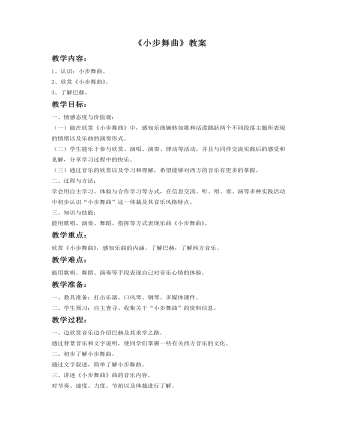
《小步舞曲教案》教案
教学过程:一、边欣赏音乐边介绍巴赫及其求学之路。通过背景音乐和文字说明,使同学们掌握一些有关西方音乐的文化。二、初步了解小步舞曲。通过文字叙述,简单了解小步舞曲。三、讲述《小步舞曲》曲的音乐内容。对节奏、速度、力度、节拍以及体裁进行了解。四、结合谱例分段学习《小步舞曲》。1、学习乐曲A’段。说明:依据乐曲创作背景,合理创设“舞会”情景,从而有效激发学生学习兴趣,用舞蹈表现手段演绎此乐段,发展了学生的舞蹈表演能力,享受到美的愉悦。2、学习乐曲B段。说明:利用形象、直观的图式辅助以及一系列贴近学生思维逻辑的问答讨论,激发学生的思考,帮助学生准确把握乐段情绪,并能用指挥、伴奏等方式表现该乐段。3、完整欣赏《小步舞曲》。说明:学生在完整欣赏乐曲时能够巩固乐曲主题的记忆,并且听辨、感受乐曲两个不同主题情绪,培养学生独立的音乐感受和见解。五、视频欣赏。说明:通过视屏欣赏,使同学们以一个更直观的郊区去理解和学习作品,并使同学对作品有更深刻的记忆。引起学生共鸣,领悟音乐的美感,愉悦身心,获取乐趣,从而激起学习的情趣。
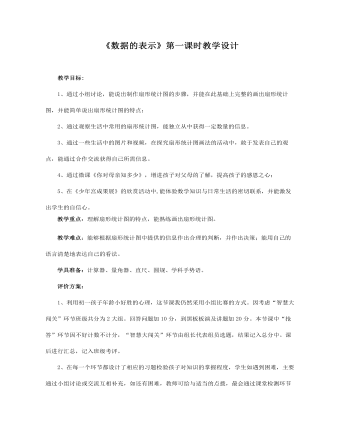
数据的收集与整理 3 数据的表示教案教学设计
创设情境,导入新课:你对母亲知多少师问1:我们5月份刚过了一个重要的节日,你知道是什么吗?----母亲节。师问2:那你知道妈妈的生日吗?(举手示意),每个妈妈都知道自己孩子的生日,请不知道的同学回家了解一下,多关心一下自己的父母。师问3:那你知道妈妈最爱吃的菜吗?你可以选择知道、不知道或者是没有爱吃的(拖动白板上相对应的表情符号)。请大家用不同的手势表示出来。我找3名同学统计各组的数据,写在黑板上(随机找3名学生数人数)。下面我来随机采访一下:你妈妈最喜欢吃的菜是什么?(教师随机采访,结合营养搭配和感恩教育)
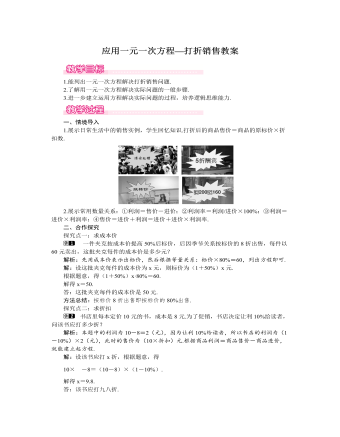
北师大初中七年级数学上册应用一元一次方程——打折销售教案1
方法总结:让利10%,即利润为原来的90%.探究点三:求原价某商场节日酬宾:全场8折.一种电器在这次酬宾活动中的利润率为10%,它的进价为2000元,那么它的原价为多少元?解析:本题中的利润为(2000×10%)元,销售价为(原价×80%)元,根据公式建立起方程即可.解:设原价为x元,根据题意,得80%x-2000=2000×10%.解得x=2750.答:它的原价为2750元.方法总结:典例关系:售价=进价+利润,售价=原价×打折数×0.1,售价=进价×(1+利润率).三、板书设计本节课从和我们的生活息息相关的利润问题入手,让学生在具体情境中感受到数学在生活实际中的应用,从而激发他们学习数学的兴趣.根据“实际售价=进价+利润”等数量关系列一元一次方程解决与打折销售有关的实际问题.审清题意,找出等量关系是解决问题的关键.另外,商品经济问题的题型很多,让学生触类旁通,达到举一反三,灵活的运用有关的公式解决实际问题,提高学生的数学能力.
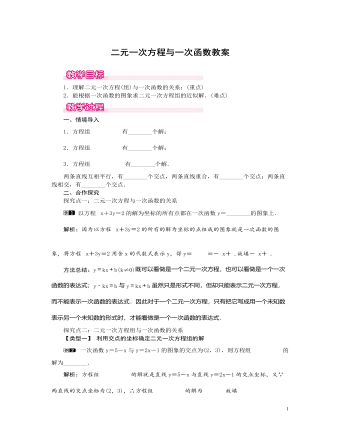
北师大初中数学八年级上册二元一次方程与一次函数1教案
由②得y=23x+23.在同一直角坐标系中分别作出一次函数y=3x-4和y=23x+23的图象.如右图,由图可知,它们的图象的交点坐标为(2,2).所以方程组3x-y=4,2x-3y=-2的解是x=2,y=2.方法总结:用画图象的方法可以直观地获得问题的结果,但不是很准确.三、板书设计1.二元一次方程组的解是对应的两条直线的交点坐标;2.用图象法解二元一次方程组的步骤:(1)变形:把两个方程化为一次函数的形式;(2)作图:在同一坐标系中作出两个函数的图象;(3)观察图象,找出交点的坐标;(4)写出方程组的解.通过引导学生自主学习探索,进一步揭示了二元一次方程和函数图象之间的对应关系,很自然的得到二元一次方程组的解与两条直线的交点之间的对应关系.进一步培养了学生数形结合的意识,充分提高学生数形结合的能力,使学生在自主探索中学会不同数学知识间可以互相转化的数学思想和方法.
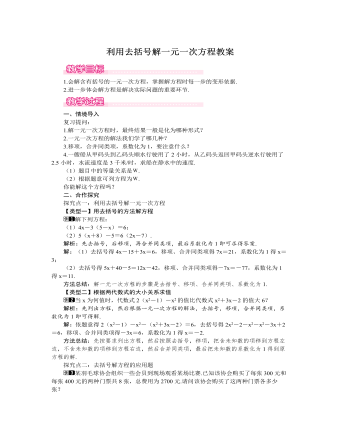
北师大初中七年级数学上册利用去括号解一元一次方程教案1
解:设每张300元的门票买了x张,则每张400元的门票买了(8-x)张,由题意得300x+400×(8-x)=2700,解得x=5,∴买400元每张的门票张数为8-5=3(张).答:每张300元的门票买了5张,每张400元的门票买了3张.方法总结:解题的关键是熟练掌握列方程解应用题的一般步骤:①根据题意找出等量关系;②列出方程;③解方程;④作答.三、板书设计本节课的教学先让学生回顾上一节所学的知识,复习巩固方程的解法,让学生进一步明白解方程的步骤是逐渐发展的,后面的步骤是在前面步骤的基础上发展而成的.然后通过一个实际问题,列出一个有括号的方程,大胆放手让学生去探索、猜想各种解法,去尝试各种解题的途径,启发学生在化归思想影响下想到要去括号.
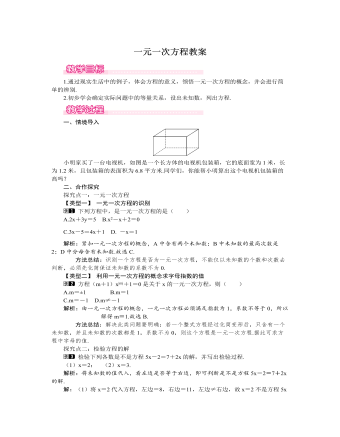
北师大初中七年级数学上册一元一次方程教案1
某文具店一支铅笔的售价为1.2元,一支圆珠笔的售价为2元.该店在“6·1儿童节”举行文具优惠售卖活动,铅笔按原价打8折出售,圆珠笔按原价打9折出售,结果两种笔共卖出60支,卖得金额87元.若设铅笔卖出x支,则依题意可列得的一元一次方程为( )A.1.2×0.8x+2×0.9(60+x)=87B.1.2×0.8x+2×0.9(60-x)=87C.2×0.9x+1.2×0.8(60+x)=87D.2×0.9x+1.2×0.8(60-x)=87解析:设铅笔卖出x支,根据“铅笔按原价打8折出售,圆珠笔按原价打9折出售,结果两种笔共卖出60支,卖得金额87元”,得出等量关系:x支铅笔的售价+(60-x)支圆珠笔的售价=87,据此列出方程为1.2×0.8x+2×0.9(60-x)=87.故选B.方法总结:解题的关键是读懂题意,设出未知数,找到题目当中的等量关系,最后列方程.三、板书设计教学过程中,通过对多种实际问题情境的分析,感受方程作为刻画现实世界有效模型的意义,通过观察、归纳一元一次方程的概念,使学生在分析实际问题情境的活动中体会数学与现实的密切联系.
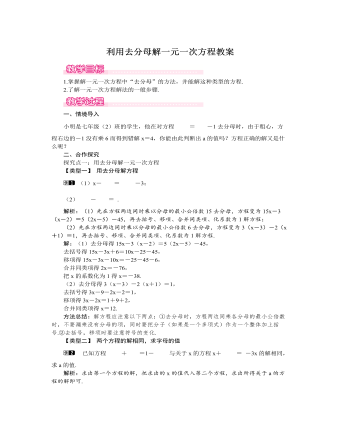
北师大初中七年级数学上册利用去分母解一元一次方程教案1
探究点三:列一元一次方程解应用题某单位计划“五一”期间组织职工到东湖旅游,如果单独租用40座的客车若干辆则刚好坐满;如果租用50座的客车则可以少租一辆,并且有40个剩余座位.(1)该单位参加旅游的职工有多少人?(2)如同时租用这两种客车若干辆,问有无可能使每辆车刚好坐满?如有可能,两种车各租多少辆?(此问可只写结果,不写分析过程)解析:(1)先设该单位参加旅游的职工有x人,利用人数不变,车的辆数相差1,可列出一元一次方程求解;(2)可根据租用两种汽车时,利用假设一种车的数量,进而得出另一种车的数量求出即可.解:(1)设该单位参加旅游的职工有x人,由题意得方程x40-x+4050=1,解得x=360,答:该单位参加旅游的职工有360人;(2)有可能,因为租用4辆40座的客车、4辆50座的客车刚好可以坐360人,正好坐满.方法总结:解题关键是要读懂题目的意思,根据题目给出的条件,找出合适的等量关系,列出方程再求解.
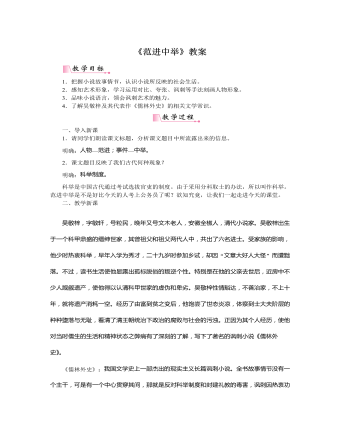
部编版语文九年级上册《范进中举》教案
目标导学一:了解作者,了解作品吴敬梓,字敏轩,号粒民,晚年又号文木老人,安徽全椒人,清代小说家。吴敬梓出生于一个科甲鼎盛的缙绅世家,其曾祖父和祖父两代人中,共出了六名进士。受家族的影响,他少时热衷科举,早年入学为秀才,二十九岁时参加乡试,却因“文章大好人大怪”而遭黜落。不过,读书生活使他显露出孤标脱俗的叛逆个性。特别是在他的父亲去世后,近房中不少人觊觎遗产,使他得以认清科甲世家的虚伪和卑劣。吴敬梓性情豁达,不善治家,不上十年,就将遗产消耗一空。经历了由富到贫之变后,他饱尝了世态炎凉,体察到士大夫阶层的种种堕落与无耻,看清了清王朝统治下政治的腐败与社会的污浊。正因为其个人经历,使他对当时儒生的生活和精神状态之弊病有了深刻的了解,写下了著名的讽刺小说《儒林外史》。

北师大初中八年级数学下册三角形的全等和等腰三角形的性质教案
证明:过点A作AF∥DE,交BC于点F.∵AE=AD,∴∠E=∠ADE.∵AF∥DE,∴∠E=∠BAF,∠FAC=∠ADE.∴∠BAF=∠FAC.又∵AB=AC,∴AF⊥BC.∵AF∥DE,∴DE⊥BC.方法总结:利用等腰三角形“三线合一”得出结论时,先必须已知一个条件,这个条件可以是等腰三角形底边上的高,可以是底边上的中线,也可以是顶角的平分线.解题时,一般要用到其中的两条线互相重合.三、板书设计1.全等三角形的判定和性质2.等腰三角形的性质:等边对等角3.三线合一:在等腰三角形的底边上的高、中线、顶角的平分线中,只要知道其中一个条件,就能得出另外的两个结论.本节课由于采用了动手操作以及讨论交流等教学方法,有效地增强了学生的感性认识,提高了学生对新知识的理解与感悟,因而本节课的教学效果较好,学生对所学的新知识掌握较好,达到了教学的目的.不足之处是少数学生对等腰三角形的“三线合一”性质理解不透彻,还需要在今后的教学和作业中进一步巩固和提高
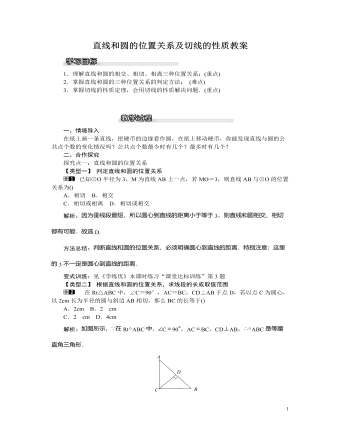
北师大初中九年级数学下册直线和圆的位置关系及切线的性质教案
解析:(1)由切线的性质得AB⊥BF,因为CD⊥AB,所以CD∥BF,由平行线的性质得∠ADC=∠F,由圆周角定理的推论得∠ABC=∠ADC,于是证得∠ABC=∠F;(2)连接BD.由直径所对的圆周角是直角得∠ADB=90°,因为∠ABF=90°,然后运用解直角三角形解答.(1)证明:∵BF为⊙O的切线,∴AB⊥BF.∵CD⊥AB,∴∠ABF=∠AHD=90°,∴CD∥BF.∴∠ADC=∠F.又∵∠ABC=∠ADC,∴∠ABC=∠F;(2)解:连接BD,∵AB为⊙O的直径,∴∠ADB=90°,∴∠A+∠ABD=90°.由(1)可知∠ABF=90°,∴∠ABD+∠DBF=90°,∴∠A=∠DBF.又∵∠A=∠C,∴∠C=∠DBF.在Rt△DBF中,sin∠DBF=sinC=35,DF=6,∴BF=10,∴BD=8.在Rt△ABD中,sinA=sinC=35,BD=8,∴AB=403.∴⊙O的半径为203.方法总结:运用切线的性质来进行计算或论证,常通过作辅助线连接圆心和切点,利用垂直构造直角三角形解决有关问题.

